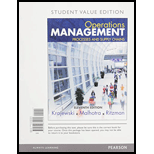
Interpretation:Economies and diseconomies of scale of college class size and its symptoms and the way these symptoms are related to customer contact are to be determined.
Concept Introduction:Economies of scale are the benefits that a firm reaps when it increases its production over a certain level. These are the benefits which a firm gets by reducing average cost and increasing output level.
Diseconomies are the disadvantages or the loses which a firm incurs when it increases output beyond a certain level. Firm incurs loses when average cost of production increases due to over production.
Explanation of Solution
As college class size increases, it means more number of students are enrolled, it results in economies of scale. Economies of scale results in usage of skills of teacher for bigger class and teacher’s pay over a bigger class.
Diseconomies of scale arise due to increase in class size. As size increases, correction of homework, regular test, updates about student’s activities, their performance, aids and
In long-run, area of class size also increases. Side effects of diseconomies of scale setting in are unfilled vacancies of educators, uninterested profile and unmotivated teachers.
In the event that nearby client contact is required for this sort of administration process, diseconomies of scale tend to set in before.
These symptoms negatively impact customer contact as increase in number of students leads to mismanagement of the data that results in losing of customer contact.
Want to see more full solutions like this?
Chapter 4 Solutions
Operations Management: Processes and Supply Chains, Student Value Edition Plus MyLab Operations Management with Pearson eText -- Access Card Package (11th Edition)
- Define risk management and explain its importance in a small business.arrow_forward1. Define risk management and explain its importance in a small business. 2. Describe three types of risks commonly faced by entrepreneurs. 3. Explain the purpose of a risk register. 4. List and briefly describe four risk response strategies. (5 marks) (6 marks) (4 marks) (8 marks) 5. Explain how social media can pose a risk to small businesses. (5 marks) 6. Identify and describe any four hazard-based risks. (8 marks) 7. Mention four early warning indicators that a business may be at risk. (4 marks)arrow_forwardState whether each of the following statements is TRUE or FALSE. 1. Risk management involves identifying, analysing, and mitigating risks. 2. Hazard risks include interest rate fluctuations. 3. Entrepreneurs should avoid all forms of risks. 4. SWOT analysis is a tool for risk identification. 5. Scenario building helps visualise risk responses. 6. Risk appetite defines how much risk an organisation is willing to accept. 7. Diversification is a risk reduction strategy. 8. A risk management framework must align with business goals. 9. Political risk is only relevant in unstable countries. 10. All risks can be eliminated through insurance.arrow_forward
- 9. A hazard-based risk includes A. Political instability B. Ergonomic issues C. Market demand D. Taxation changesarrow_forward8. Early warning indicators help businesses to A. Avoid legal actions B. Grow rapidly C. Detect potential risks D. Hire employees 9. A hazard-based risk includes A. Political instability B. Ergonomic issues C. Market demand D. Taxation changesarrow_forward10. Which risk category refers to taking advantage of a new opportunity despite potential challenges? A. Hazard B. Uncertainty C. Opportunity D. Strategicarrow_forward
- 6. A business continuity plan is mainly used to_ A. Increase profits B. Handle daily tasks C. Prepare for disruptions D. Advertise services 7. What is the role of a risk owner? A. To finance the risk B. To monitor and manage a specific risk C. To create risks D. To avoid planning 8. Early warning indicators help businesses to_ A. Avoid legal actions B. Grow rapidly C. Detect potential risks D. Hire employees 9. A hazard-based risk includes_ A. Political instability B. Ergonomic issues C. Market demand D. Taxation changesarrow_forwardFill in the table below with the activity times after crashing to show the resulting schedule. (Enter your responses as whole numbers.) Activity A B с Time according to schedule (weeks) Activity F G H Time according to schedule (weeks) D E COEarrow_forwardGiven the information below, estimate the probability that the noncritical path B-F-G will take more than 20 weeks. Hint: Subtract from 1.0 the probability that B-F-G will take 20 weeks or less. Refer to the standard normal table. Activity A Expected Time (weeks) Variance 3.5 1.00 BCDE 5.5 0.96 C 4.0 0.45 12.0 1.78 6.5 2.25 F G 9.0 2.78 4.5 0.69 The probability that this path will take more than 20 weeks to complete is (Enter your response rounded to four decimal places.)arrow_forward
 Purchasing and Supply Chain ManagementOperations ManagementISBN:9781285869681Author:Robert M. Monczka, Robert B. Handfield, Larry C. Giunipero, James L. PattersonPublisher:Cengage Learning
Purchasing and Supply Chain ManagementOperations ManagementISBN:9781285869681Author:Robert M. Monczka, Robert B. Handfield, Larry C. Giunipero, James L. PattersonPublisher:Cengage Learning Practical Management ScienceOperations ManagementISBN:9781337406659Author:WINSTON, Wayne L.Publisher:Cengage,
Practical Management ScienceOperations ManagementISBN:9781337406659Author:WINSTON, Wayne L.Publisher:Cengage,- MarketingMarketingISBN:9780357033791Author:Pride, William MPublisher:South Western Educational Publishing
 Management, Loose-Leaf VersionManagementISBN:9781305969308Author:Richard L. DaftPublisher:South-Western College Pub
Management, Loose-Leaf VersionManagementISBN:9781305969308Author:Richard L. DaftPublisher:South-Western College Pub





